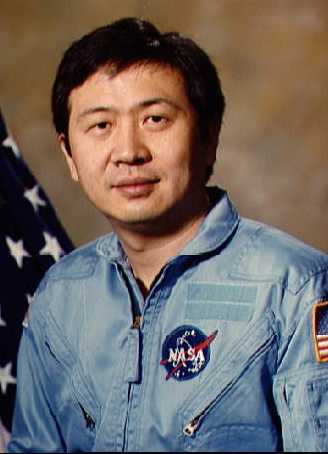- Taylor Wang
Infobox Astronaut
name =Taylor Gun-Jin Wang

type =JPL Payload Specialist
nationality =American / Chinese
date_birth =June 16 ,1940
place_birth =Shanghai ,China
occupation =Scientist
selection =
time =7d 00h 08m
mission =STS-51-B
insignia =|Taylor Gun-Jin Wang (zh-tsp |t=王贛駿 |s=王赣骏 |p=Wáng Gànjùn) (born
June 16 ,1940 ) is an American scientist and in 1985, became the first ethnic Chinese person to go into space. While an employee of theJet Propulsion Laboratory , Wang was apayload specialist on theSpace Shuttle Challenger missionSTS-51-B .With ancestry in
Yancheng ,Jiangsu ,China , Wang was born inShanghai to Wang Zhang (王章) and Yu Jiehong (俞潔虹). He moved toTaiwan in1952 with his family. He studied his later part ofelementary school inKaohsiung , and graduated from theThe Affiliated Senior High School of National Taiwan Normal University inTaipei . He later moved toHong Kong . He started studying physics inUCLA in1963 , and received hisM.S. in 1968, and his doctoral influid mechanics in1968 andsolid state physics in 1971.After completing his doctorate, Wang joined the
California Institute of Technology 'sJet Propulsion Laboratory (JPL) in 1972, as a senior scientist. At JPL he was responsible for the inception and development of containerless processing science and technology research. He was the Principal Investigator (PI) on the Spacelab 3 mission NASA Drop Dynamics (DDM) experiments, PI on the NASA SPAR Flight Experiment #77-18 "Dynamics of Liquid Bubble," PI on the NASA SPAR Flight Experiment #76-20 "Containerless Processing Technology," and PI on the Department of Energy Experiment "Spherical Shell Technology."He gained US
citizenship in 1975, and published a paper on dynamic behavior of rotating spheroids in zero gravity the next year. The paper received attention inNASA , and Wang was selected as a payload specialist onJune 1 ,1983 for the Spacelab-3 mission.Wang conducted precursor drop dynamics experiments for the DDM in ground-based laboratories employing acoustic levitation systems, neutral buoyancy systems and drop towers, and in the near weightless environment provided by JSC's KC-135 airplane flights and SPAR rockets. These flights have helped to define the experimental parameters and procedures in the DDM experiments performed on Spacelab 3. He is the inventor of the acoustic levitation and manipulation chamber for the DDM and is the author of 70 articles in open literature and 20 U.S. patents.
Wang flew on
STS-51B Challenger (April 29-May 6, 1985). STS-51B/Spacelab-3 was launched from Kennedy Space Center, Florida, and returned to land at Edwards Air Force Base, California. It was the first operational Spacelab mission. The seven-man crew aboard Challenger conducted investigations in crystal growth, drop dynamics leading to containerless material processing, atmospheric trace gas spectroscopy, solar and planetary atmospheric simulation, cosmic rays, laboratory animals and human medical monitoring. At mission conclusion, Wang traveled over 2.9 million miles in 110 Earth orbits, and logged over 168 hours in space.Wang later became a professor at
Vanderbilt University ,Tennessee . He has written about 180 articles on drop and bubble dynamics, collision and coalescence of drops, charged drop dynamics, containerless science, and encapsulation of living cells. His experiments were carried out in 1992 in United States Microgravity Laboratory 1 (USML-1), and in 1995 aboard USML-2.Wang is married to Xueping Feng (馮雪平) with two sons, Kenneth Wang and Eric Wang.
External links
* [http://www.spacefacts.de/bios/astronauts/english/wang_taylor.htm A profile & portrait]
* [http://www.jsc.nasa.gov/Bios/htmlbios/wang-t.html NASA biography]
* [http://frontweb.vuse.vanderbilt.edu/vuse_web/directory/facultybio.asp?FacultyID=36 Wang's biography at Vanderbilt]
* [http://www.spacefacts.de/bios/astronauts/english/wang_taylor.htm Spacefacts biography of Taylor Wang]
Wikimedia Foundation. 2010.
